The Best Platforms To Sell Videos Online (2024 Guide)
Welcome to our roundup of the best platforms to sell videos.
In this post, we’ll reveal the best places for content creators and entrepreneurs to list their videos for sale online.
We’ve made sure to include a good mix of different kinds of ecommerce solutions, video-on-demand (VOD) websites, and marketplaces.
So whether you’re selling short films, video courses, workout programs, stock footage, or anything else, you’re sure to find a platform that fits your needs here.
The best platforms to sell videos compared
TL;DR:
- Sellfy is the best option for content creators and entrepreneurs that want to sell videos on demand. At its heart is a powerful but easy-to-use ecommerce store builder that allows you to sell more than just video content.
- Vimeo is the best option if you don’t want to build your own website. It’s a powerful video hosting and sharing solution that comes with a ton of powerful creator tools. You can sell videos on Vimeo as ‘to rent’ or ‘to buy’, or even via monthly subscriptions, and you get to keep 90% of your revenue.
- Uscreen is a turn-key video-on-demand (VOD) and over-the-top (OTT) platform built for creators. Like Sellfy, you can use it to build your own website and sell your video content through subscriptions, one-time purchases, or video rentals. It’s very advanced, but it’s also significantly more expensive than Sellfy.
#1 – Sellfy
Sellfy is our top pick for the overall best platform to sell videos online. It’s an easy-to-use ecommerce platform built for creators. Use it to build your own ecommerce store and sell videos and other types of products (including print-on-demand merch) directly to your audience.
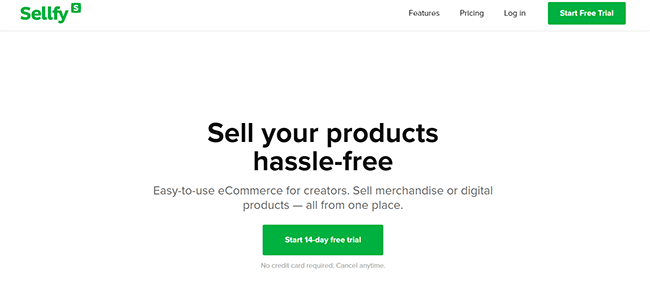
The great thing about selling your videos through your own Sellfy store is that there’s no middleman to take a cut of your profits. Sellfy doesn’t charge any transaction fees, so you keep 100% of your sales revenue.
All you have to do is sign up for one of Sellfy’s affordable monthly subscription plans, and you’ll have all the tools you need at your fingertips.
The drag-and-drop Store Customizer and premade store themes make it easy to build your storefront. Plus, you also get a lightning-fast checkout, built-in marketing tools, and more.
Once you’ve built your store, just upload your videos as a digital product and connect your preferred payment processor (Stripe or PayPal) to start selling.
Pretty much all video file formats are supported: MP4, AVI, WebM, etc. And Sellfy offers unlimited bandwidth and storage on all plans (with a 10GB file size limit), so you can upload as many videos as you want.
When you upload your videos to your store, you get to choose whether you want to make them downloadable or streamable. And Sellfy handles fulfillment for you: It automatically generates download and watch links and delivers them to the customer.
Key features
- Website builder
- Pre-built themes
- Checkout
- Unlimited products
- Downloadable/streamable videos
- Email marketing
- PayPal & Stripe integration
- Print-on-demand fulfillment
- Store embed
Pros
- Easy to use
- Complete ownership and contro
- Sell all types of products (not just video)
- Unlimited video uploads
- Supports both video downloads and streams
Cons
- No existing audience to tap into
- Capped at $10k-$200k in sales per year (depending on your plan)
Pricing
Plans start at $29/month and yearly and two-yearly discounts are available. Get started with a 14-day free trial.
Read our Sellfy review.
#2 – Vimeo On Demand
Vimeo On Demand is an all-in-one video monetization platform that you can use to create, share, and sell your video content. There’s a free Vimeo plan but you’ll need a Vimeo PRO subscription to create On Demand pages and start selling videos to your audience.

If you choose to sell videos through Vimeo On Demand, you have a lot of flexibility when it comes to pricing. You’ll have the option of letting users rent your videos, buy them, or access them by paying for a recurring subscription.
You also get to decide what countries you want to distribute your video content to. For example, you can make the content available worldwide, or only in certain regions. And you can exclude specific countries.
When you make a sale, Vimeo automatically deducts transaction fees of between 4% and 17%, as well as VAT/sales tax where applicable. Then, you’ll take 90% of whatever is left over, and Vimeo will take the other 10% as their cut. This is a pretty generous revenue split as you still get to take home most of your profit.
Another great thing about selling through Vimeo is that it already has a huge global audience, which helps with discovery. And to reach even more potential customers, you can embed your video trailers anywhere across the web with in-player purchase buttons.
Key features
- Video creation and editing tools
- Unlimited videos
- Video templates
- 2TB bandwidth/month
- 4K & HDR support
- Embed anywhere
- In-player purchases
- Rent, buy, and subscription options
- Automated CCs
- Analytics
Pros
- Powerful creator tools
- Global reach
- Generous revenue split
- Flexible pricing options
Cons
- Vimeo takes a small cut of your sales revenue (10%)
- Less control/ownership than selling through your own website
Pricing
Free plan available. The PRO plan, which is suitable for selling VOD, starts at $20/month with annual billing. Get started with a 14-day free trial.
#3 – Uscreen
Uscreen is one of the most advanced VOD and OTT platforms out there. It offers more ways to sell than Sellfy and a ton of powerful features to help you manage, market, and grow your business.
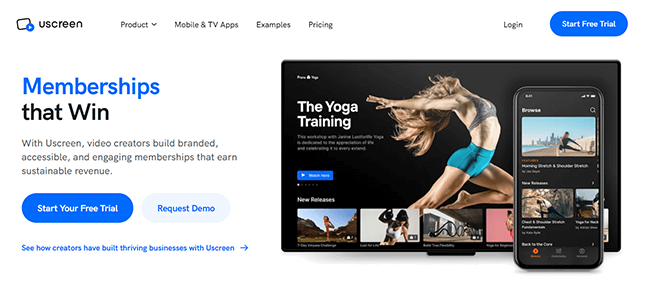
With Uscreen, you can sell your video content through subscriptions, and one-time sales. Or alternatively, offer them for free and monetize them through donations, tips, live-streaming events, etc.
It’s used by over 25,000 creators, including popular YouTubers like Mr Beast, Justin Rhodes, and Vanesa Seco.
Uscreen’s best-in-class feature set includes an intuitive website and landing page builder, a Netflix-style video catalog, live streaming capabilities, community spaces, mobile and TV app builder, marketing and analytics tools, automations, CMS, and more.
Key features
- Video CMS
- Customizable website
- Flexible pricing
- Marketing tools
- Automations
- Analytics
- Mobile apps
- TV streaming apps
- Live streaming
- Extensive integrations
Pros
- All-in-one feature set
- Best-in-class video management tools
- Lots of monetization/selling options
Cons
- Expensive monthly subscription plans
Pricing
Plans start at $99/month (+$0.99 per subscriber/month), get 20% off when you pay annually. Free trial available.
#4 – Prime Video Direct
Prime Video Direct is the best solution for independent filmmakers. It lets you sell your videos through Amazon Prime, one of the most popular VOD subscription services in the world.

Amazon Prime has an enormous global reach, with millions of users. So needless to say, if you can get your videos listed for sale on Prime Video, it’ll make it much easier to make sales.
And the way to do that is to submit your videos to Prime Video Direct for licensing consideration. If you’re accepted, you can make your content available to rent or buy on Prime Video, and you’ll be paid 50% of the net revenue from your sales.
The only problem is that it can be tough to get licensed. Amazon Prime only typically licenses professionally produced, feature-length movies or TV shows. And you’re much more likely to get accepted if your content has already been shown on a major TV network or at a film festival.
There are also some technical requirements to be aware of. You’ll need to submit your mezzanine, along with a captions file (depending on your location), and graphic assets.
Key features
- Sell through Prime Video marketplace
- Global audience
- Performance metrics
- Optimization
- Video management
Pros
- Huge global reach
- High conversion rate
- Great reputation
- Lends credibility to creators
Cons
- Can be tough to get licensed
- Only pays out 50% of your net revenue
Pricing
Prime Video Direct is free to use. However, you’ll only be paid 50% of your revenue.
#5 – Alamy
Alamy is the best platform to use if you’re selling stock videos. It’s an online marketplace where users can search for and purchase stock images, vectors, and videos from the world’s leading creators.

Content on Alamy typically sells for higher prices compared to other stock footage websites as it caters to the higher end of the market.
And it’s also less competitive/saturated compared to sites like Shutterstock, so it can be easier to make sales.
Commission rates range from 17% to 66% depending on your contributor contract and a number of factors. In total, Alamy pays out over $ 1 million every month to its contributors.
Key features
- Sell stock videos and images
- Analytics
- Contributor tools
- Captions and tagging
- Content management
- Non-exclusive and exclusive licensing options
- $50 minimum payout threshold
Pros
- Large existing customer base
- Less competitive than other stock sites
- High average sale price
- No subscription costs
Cons
- Low commission rates
- Less control compared to selling through your own site
Pricing
It’s free to sell on Alamy but you’ll only be paid a fraction of your video sales revenue as commission.
#6 – Videohive
Videohive is another good choice for selling stock footage and video templates. It’s one of the websites under the Envato umbrella, so it has a huge base of existing customers to tap into.
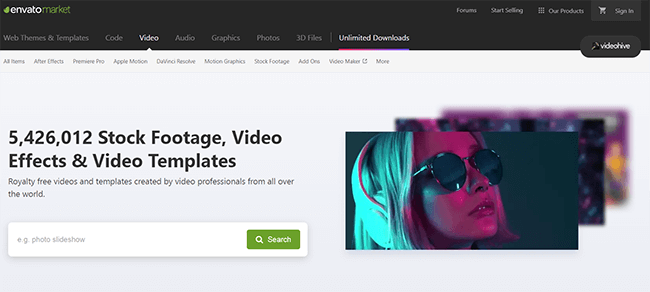
Videos on Videohive typically sell for around $30-$60 apiece. There are lots of different types of video content you can sell, including royalty-free videos, video intros/openers, stock footage, video templates, and motion graphics.
The customer base tends to be other creatives as well as brands and professionals, so videos that appeal to this target audience tend to sell the best.
Key features
- Easy video uploads
- Exclusive and non-exclusive options
- Analytics
- Daily insights
- Community support
Pros
- Great for selling royalty-free videos
- Easy sign-up process
- Well-defined target audience
- Huge audience
Cons
- Less control/ownership
- Not suitable for selling movies/documentaries/tv shows
Pricing
It’s free to sell on Videohive through Envato Market. Commission rates vary.
#7 – Thinkific
Thinkific is our top-recommended platform for creators who want to sell video courses online.
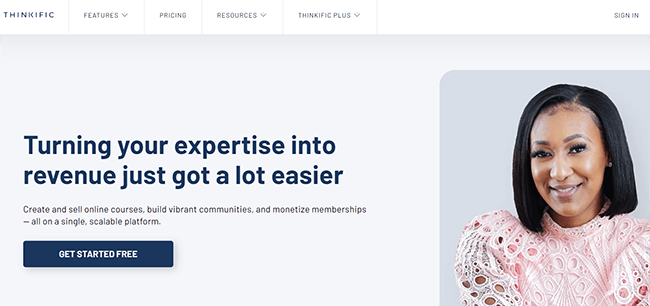
It’s an all-in-one course platform & LMS that gives you everything you need to sell educational video content online.
First, you can use the drag-and-drop website builder to create your website, complete with sales pages, an instructor bio page, etc.
Then, you can use the course builder to create the course itself. You can upload your educational video content to individual lessons and supplement those videos with text, downloads, assessments, etc.
You also get access to flexible pricing options, community-building tools, marketing tools, and more.
Key features
- Website themes
- Course builder
- E-commerce features
- Assessments
- Student management
- Live stream lessons
- Marketing tools
Pros
- Ideal for selling educational videos/courses
- All-in-one feature set
- 0% transaction fees
- Highly flexible and customizable
- Complete control and ownership
Cons
- Only suitable for video courses (can’t sell other types of videos)
- Takes time to set everything up
Pricing
Free plan available. Paid plans start from $49/month, save 25% by paying annually.
#8 – OnlyFans
OnlyFans is a creative marketplace where creators can share video content and sell subscription memberships.
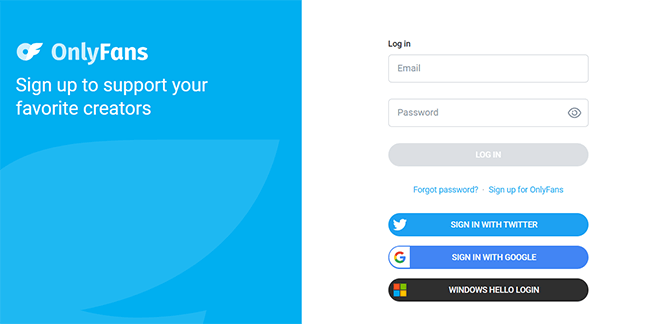
Lately, OnlyFans has become famous as a place to sell adult-only video content, but it can also be a good option for other types of creators too, such as coaches, fitness influencers, and more.
Using OnlyFans, you can create a members-only space to share your content. It not only gives you the opportunity to privately host and share video content with your subscribers, but you can also use it to share written posts, photos, and even social stories. Think of it like a gated social media account that can only be accessed by paying subscribers.
The benefit of using OnlyFans is that it’s much easier to get started with than creating your own membership-style site.
However, it has got quite an infamous reputation as a place for sharing x-rated content, so it’s worth considering whether or not this might be a problem for your audience and subscribers before using the platform.
Key features
- Video hosting
- Video sharing
- Members only space
- Subscription-based pricing model
- Additional content features like stories and image sharing
Pros
- Simple alternative to a subscription site
- Wide user base
- Easy to get started
Cons
- Associated with mainly adult content
- High fees
Pricing
OnlyFans is free to use, but they charge 20% fees on earnings.
#9 – Patreon
Patreon is a community-centric platform that allows you to receive donations or subscriptions from your followers in exchange for exclusive perks or content. Although you can’t use it to host your videos, you can use it to sell access to your exclusive video content via monthly subscriptions.
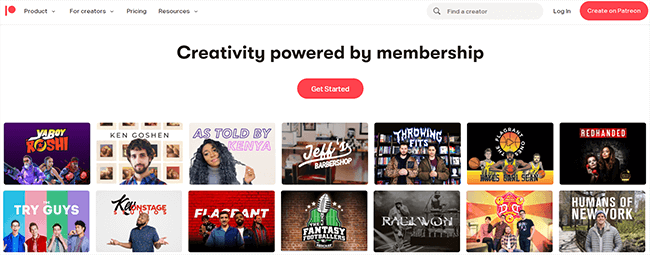
Basically, the way Patreon works is that your Patrons pay a monthly fee to get access to exclusive perks.
That might include access to any content that you share on your Patreon account, so if you wanted to share exclusive video content with them, you could upload it as unlisted on YouTube and share it only with your patrons.
Patreon is a great choice for creators that already have a good following on YouTube or other social media platforms that want to make some extra income from creating an exclusive paid community space.
You don’t just have to use it to share video content, you can also offer other incentives and perks for paying patrons, such as postcards, exclusive merch, or just the opportunity to access your Patreon channel and interact with you and other community members.
Overall, it’s a great way to sell and share your videos and create a subscription-style community without building your own subscription site.
Key features
- Communicate with fans and subscribers
- Receive ‘donations’ or subscription fees from patrons
- Share members-only content to your feed
- Create a variety of subscription tiers
- Integrates with hosting platforms like Vimeo, Discord, YouTube and more
Pros
- Easy-to-use
- A well-known platform for viewers and creators
- A simple way of creating a members-only space
Cons
- No video hosting capabilities
Pricing
Patreon is free to use, but the company takes a percentage fee of 5-12% of your earnings based on the plan you choose.
Frequently asked questions
Before we wrap up, here are the answers to some frequently asked questions about selling videos online.
Can I sell my videos on YouTube?
No. Unfortunately, you can’t sell videos directly through YouTube. However, you can use YouTube as a marketing channel to promote the videos you sell on other platforms.
For example, you could upload trailers and clips from your paid video content on YouTube, and then include a CTA and link in your description that invites viewers to your Sellfy store in order to purchase the full video.
You can also monetize the videos that you upload to YouTube in other ways, such as through the YouTube Partner Program, affiliate marketing, etc.
How much does Vimeo pay?
Vimeo pays creators 90% of the gross revenue they earn after transaction costs (fees and VAT/sales tax) have been deducted. So the amount you’ll be paid depends on how many videos you sell, and the price you sell them at.
The average purchase price on Vimeo is $10 and fees range from 4%-17% (not accounting for VAT). If you were to sell videos at that price, you’d likely be paid somewhere around $6-$8 per sale. If you sold 100 videos at that price, you’d be paid around $600-$800.
How much should I sell videos for?
That’s a tough question to answer as it really depends on what you think your videos are worth and how much you think your target customers will be willing to pay.
Many creators charge around $10 per video—this seems to be the sweet spot.
However, for very short videos/stock footage sold under non-exclusive licenses, you might charge as little as $1 or less. And for full feature-length movies, you might charge upwards of $20 per video.
If you’re renting your videos, rather than selling them, you might want to price them lower (around $2-$4). And you could also consider selling videos as part of a subscription package for a recurring revenue stream.
How else can I make money through video content?
Aside from selling videos directly to customers, you can also make money through video content in other ways. Here are some ideas:
- Sell paid sponsorships to brands
- Monetize your videos with ads
- Sign up for an affiliate network & use your videos to promote affiliate offers
- Ask your viewers for donations (you can accept donations using a tool like
- Use your videos to market/sell other products (e.g. merchandise, video editing presets, etc.)
Remember: video content is just one of the many types of digital products you can sell.
How do I sell video downloads?
You can sell your videos as digital downloads through Sellfy. Just create your store, upload your video files as a digital product, and start selling. When you make a sale, Sellfy will deliver the download file to the customer automatically.
Just bear in mind that while it’s possible to sell videos as downloadable files, it’s usually a better idea to sell them as VOD content. That way, they don’t have to download huge files to their devices and instead can watch them immediately online through a built-in video player.
Fortunately, with Sellfy, you can set your videos to be downloadable or streamable.
As a side note, you can also sell digital products, physical products, and POD merch through your Sellfy store.
What type of video content is the most popular?
Some of the most popular types of video content include:
- Educational video courses
- Workout videos
- Gaming videos
- Comedy videos
- Music videos
- Live streaming videos
Conclusion
As you can see, there are plenty of platforms on the market that make it easy to sell videos. Now, it’s time to see which one fits with your needs. Be sure to consider your budget and the features that you need before anything else.
If you’re still not sure which of these video-selling platforms to choose, here’s what we’d suggest:
- Use Sellfy to build your own ecommerce website and sell videos directly to your customers if you want maximum control and you’d prefer to keep 100% of your revenue.
- Go with Vimeo if you’re looking for an easier way to sell videos online and you don’t mind splitting your revenue with your hosting platform.
- Consider Uscreen if you have a bigger budget to work with and you want a turn-key VOD solution with the very best features and creator tools
And if you’re exclusively selling educational video courses, any of these online course platforms is a great pick.
Good luck!
Disclosure: If you buy through links on our site, we may make a commission. This helps to support the running of Startup Bonsai.
